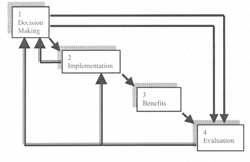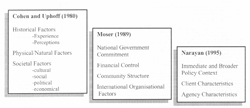The use of alternative safe water options
to mitigate the arsenic problem in Bangladesh: a community perspective
Md. Jakariya. M.Sc. Thesis,
Department of Geography, University of Cambridge, Aug 2000
CHAPTER 4. DYNAMICS
OF COMMUNITY AND COMMUNITY PARTICIPATION
The notion of community has evolved over time. Changes in
society - from primitive times to modern times - due to differences in status,
tradition, or religion, have affected the bonds between community members and
the shape of community activities. The present trends towards marketisation and urbanization
are eroding the concept of community. Modernization theorists share
this evolutionary view. Under the strong influence of Parsonian Structuralism,
they have characterized societies using the evolutionary labels of ‘under
developed,’ ‘developing’ and ‘developed’ (Agarwal and Gibson, 1999).
Historically, most communities were relatively homogeneous.
Members shared similar characteristics distinguishing them from ‘outsiders’
and lived in harmony with nature. Such harmony existed until it was ‘disrupted’,
mainly by population growth. Population growth caused the over-use and
over-exploitation of resources. This led to generalized poverty and further
environmental degradation that created a cycle of more poverty and environmental
degradation (Durning 1989). The Malthusian view saw this population growth as
leading to an endless chain of increasing poverty and misery. There was another
group - the Optimists - who did not subscribe to the Malthusian model and
believed that people or communities had the creative capacity to overcome
potential environmental disasters resulting from a growing population and
intense economic activity. Examples of where the Optimists’ views have
prevailed are probably China and Bangladesh. In such countries, large
populations are considered to be resources rather than hindrances toward
progress.
Various factors such as abrupt social change, the breakdown
of traditional authority in community resource management, commercialization,
the migration to urban areas, the immigration of foreign populations, and
inappropriate state policies have weakened the previously harmonious link
between community and nature. Therefore, what is required is to bring back the
lost harmony between environment and community by recognizing nature’s
capacity to sustain a maximum number of people and activities (IUCN/ WWF/UNEP
1991).
As we know, environments are constantly changing and emerging
as the outcome of dynamic and variable ecological processes, disturbance events,
and interaction with humans. Therefore, environments provide a setting for
social action and are clearly a product of such action. People’s actions and
practices may serve to conserve or reproduce existing ecological features or
processes (e.g. maintain a regular cycle, alter soil and vegetation,
etc.). On the other hand, people may also act as agents that transform
environments (e.g. shorten the fallow, alter the soil and vegetation
etc.) (Leach et al., 1997). Such transformations may involve precipitating
shifts of ecological states, which push ecological processes in new directions
or along new pathways. In both cases some actions may be intentional and some
not, but in any case they may have significant impact on the ecology.
Now-a-day community participation is a central goal in any
form of development activities. Participation generally denotes the involvement
of a significant number of people in situations or actions that enhance their
well-being e.g. their income, security, or self-esteem. Participation is
viewed as a means to defined ends, not as an end in itself; the goal therefore
is to optimize participation in order to achieve the desired project goals, not
simply to maximize participation. Participation does not exists in a vacuum but
is influenced by policy context, agency characteristics and community
characteristics (Narayan, 1995). If different factors that influence
participation can be identified, steps can be taken to overcome barriers and
take advantage of the opportunities.
The kinds of participation that warrant major concern are
(i)
participation in decision making, (ii) participation in implementation, (iii)
participation in benefits, and (iv) participation in evaluation (Cohen and
Uphoff, 1980).
Figure 3 : Major kinds of
Participation (Cohen and Uphoff, 1980)

Together, these four kinds of participation constitute
something of a cycle for any project activity. In practice there seldom is a
consistent or complete cycle of interactions. Participation in these different
activities is often quite limited or unequal. Yet they constitute a tangible set
of things to focus one’s attention on and to represent the major ways in which
participation in any activities can be assisted and assessed. The importance of
community participation in decision making is emphasized in the World Bank’s
definition of participation as “a process through which stakeholders influence
and share control over development initiatives and the resources, and resources
that affect them.” (World Bank, 1996). Participation at an early stage of the
decision-making process of a project can reduce both time and cost of the
project. Participation as part of a decision- making process is most likely to
achieve benefits both as a means and as an end. It is by influencing decisions
that communities are best able to ensure that their needs are met. It is also
important in empowering communities through changing the balance of power and
increasing skills and confidence (Finterbusch and Van Wicklin, 1987).
The most important aspect of community involvement at the
implementation stage is to develop the sense of ownership of the implemented
activity for long-term sustainability. Community participation in the
implementation stage of a project can also reduce costs and provide training and
employment. It can also be used as a means of exploiting the free labor of
beneficiaries. In this form, participation is nothing more than “an
ideologically-acceptable packaging for a theory of economic efficiency for the
poorest” (Jaglin, 1994).
Enlistment in a project can lead to at least three kinds of
possible benefits: material, social, and personal. Benefits are a prime
motivation for people to participate. Studies have shown that the poor are
typical in that they often place great value on independence, self-respect, and
freedom to make their own decisions (Wratten, 1995). The non-material benefits
of participation may therefore tackle poverty to an even greater extent than the
material benefits.
Because there is little written - or actually accomplished -
on participation in evaluation, it is difficult to conceptualize how this kind
of participation may best be analyzed and measured. It has been recognized that
participation in evaluation is important but rarely carried out (Cohen and
Uphoff, 1980). If direct methods of evaluation are not available, communities
will invariably evaluate projects indirectly through using patterns of the
facilities provided (Cottam 1997). In extreme circumstances, evaluation may take
the form of violence or protest (Cohen and Uphoff, 1980).
There is a wide range of factors that could hinder and
constrain the promotion of participatory development, and these often lead to
the emergence of non-participatory approaches. Such obstacles prohibiting
participation abound: they range from institutional, socio-cultural, technical,
logistical, and are spread over a seemingly-endless spectrum. Obstacles are also
‘external’, ‘internal’, and / or a combination of both. ‘External
obstacles’ refer to those factors outside the end-beneficiary community that
inhibit or prevent true community participation taking place. External obstacles
suggest the role of development professionals, the broader government
orientation towards promoting participation, the tendency among development
agencies to apply selective participation, and their technological-financial
bias. Internal obstacles refer to conflicting interest groups, gate-keeping by
local elites, and a lack of public interest in becoming involved. Some of the
obstacles such as excessive pressures for immediate results and
technological-financial bias include both internal and external characteristics.
On the other hand, factors such as culture, history,
government policy, and social, political, and economic structures influence
community participation. Individual and group motivators appear to be
context-specific and locality-bound rather than universally-definable. As
community participation grows out of a specific situation, its applicability and
replication to another region is problematic, as it encounters various and
complex problems. In this regard Galgart (1981) refers to the disillusionment of
the realization that replication of successful participatory projects is an
unsolved problem. Different authors such as Cohen and Uphoff (1980), Narayan
(1995), and Moser (1989) have identified different factors responsible for
community participation, and these are presented below:
Figure 4 : Factors influencing Community
Participation

Source : Toole, 1999.
Therefore, it can be said that due to the complexity of
community dynamics as a human process, there are neither blueprints nor
ready-made recipes of participatory processes that can be applied to promote
participatory development. Cohen and Uphoff (1980) have pointed out that there
is no ‘magic list’ of critical factors for participation. Some of the
obstacles to community participation, as mentioned earlier, have an external
influence on the end-beneficiary community (from the outside), while others are
endemic or internal to the community. The way/s in which these internal and
external obstacles inter-relate or interact with one another, is / are of vital
importance in getting a clear picture of the impact of all the different factors
and processes in promoting and facilitating community participation.
|